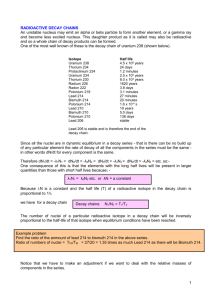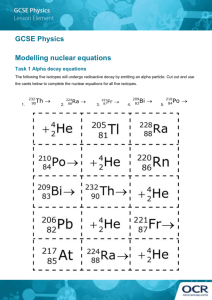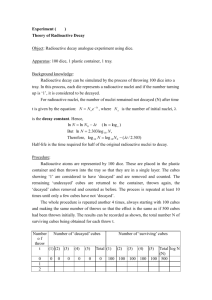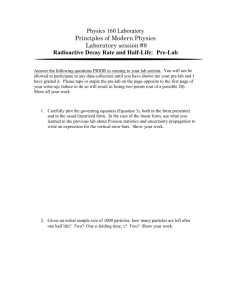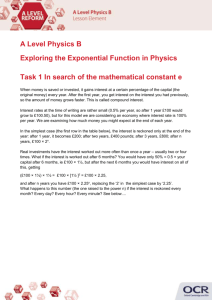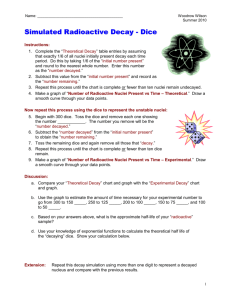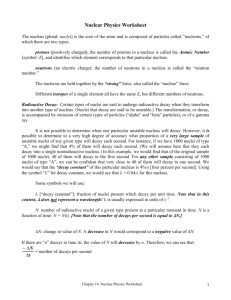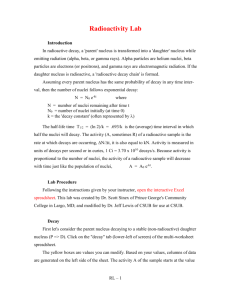EXPERIMENT 8
advertisement
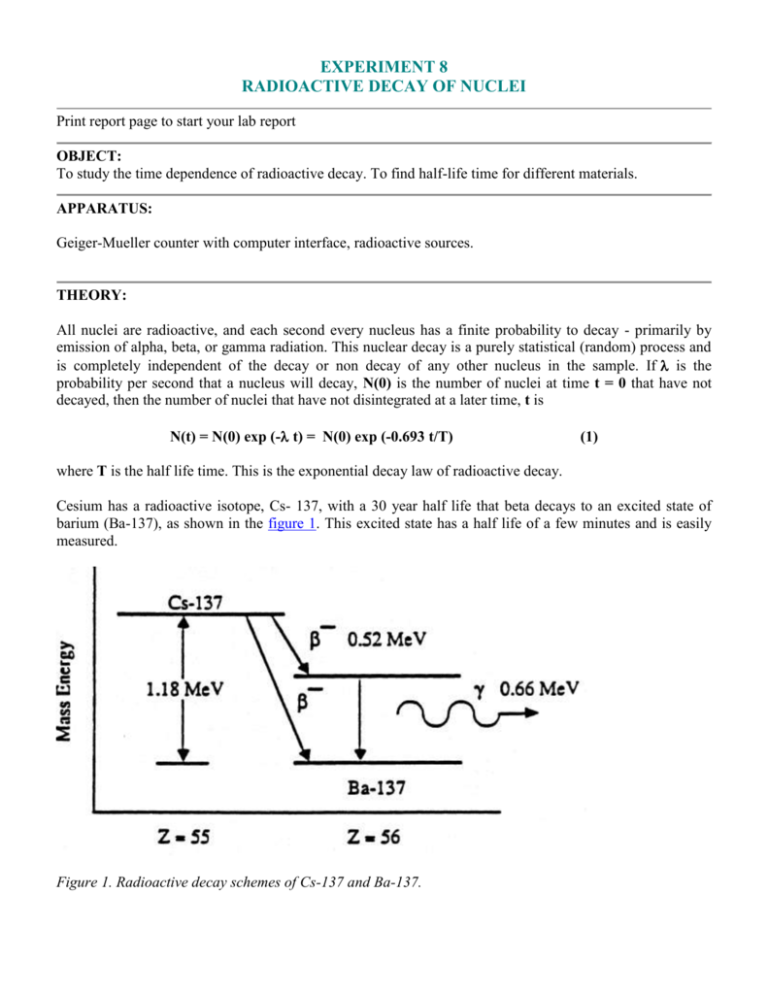
EXPERIMENT 8 RADIOACTIVE DECAY OF NUCLEI Print report page to start your lab report OBJECT: To study the time dependence of radioactive decay. To find half-life time for different materials. APPARATUS: Geiger-Mueller counter with computer interface, radioactive sources. THEORY: All nuclei are radioactive, and each second every nucleus has a finite probability to decay - primarily by emission of alpha, beta, or gamma radiation. This nuclear decay is a purely statistical (random) process and is completely independent of the decay or non decay of any other nucleus in the sample. If is the probability per second that a nucleus will decay, N(0) is the number of nuclei at time t = 0 that have not decayed, then the number of nuclei that have not disintegrated at a later time, t is N(t) = N(0) exp (- t) = N(0) exp (-0.693 t/T) (1) where T is the half life time. This is the exponential decay law of radioactive decay. Cesium has a radioactive isotope, Cs- 137, with a 30 year half life that beta decays to an excited state of barium (Ba-137), as shown in the figure 1. This excited state has a half life of a few minutes and is easily measured. Figure 1. Radioactive decay schemes of Cs-137 and Ba-137. Indium metal (49In, atomic number of 49) as found on the surface of the earth is 95.72 % mass 115 and 4.28% mass 113. (Using the nuclear masses of 114.9041 and 112.9043 instead of the number of nucleons, 115 and 113, the chemical weight of 114.82 can be calculated.) If the indium is placed where there are many free neutrons with kinetic energies, on the order of 0.03 eV, both isotopes In-115 and In-113 will absorb neutrons, and become radioactive nuclei, In-116 and In-114, respectively. Because there are so few In-113 atoms compared to In-115, and because In- 115 has a much larger probability (cross section) to capture a neutron, neutron irradiated samples of indium contain primarily In-113, In-115, and In-116 nuclei. The decay of In-116, sketched in figure 2, involves the prompt emission of two gamma rays after the nucleus beta decays to become tin, Sn-116. Figure 2. Radioactive decay scheme of In-116. Obviously, this equation will be represented as a straight line if graphed correctly on semi-log graph paper. PROCEDURE Use the Experiment 6 description to set up the counter and computer interface. Choose your operating voltage. Exercise 1. Obtain a sample of Cs-137 from your lab instructor. Immediately place it close to the GM counter and record the number of counts occurring in 20 thirty-second intervals. Do not allow more than a second or two between counting intervals. Exercise 2. Remove the cesium sample from your counter and count the background radiation from the room and cosmic rays for five minutes. This measured counting RATE must be used to correct all counting samples to remove the background contribution to the total count. Exercise 3. Obtain the irradiated indium sample (or an unknown sample) from the instructor. Place the sample as close as possible to the GM tube and record the number of counts occurring in 10 five-minute intervals. Do not delay between counting intervals. DATA ANALYSIS Exercise 1. Calculate the background radiation count per time interval used in exercise 1. Subtract the background radiation from your counts. Plot corrected data on semi-log paper and find the slope (and its error). The slope of the line will be proportional to the decay probability constant, (see equation 1), and the half-life time of the sample can be calculated as T = 0.693/= (ln 2)/ . Calculate the decay constant (with error) and the half-life time (with error). Compare your results with accepted values. Exercise 3. Calculate the background radiation count per time interval used in exercise 3. Subtract the background radiation from your counts. Plot corrected data on semi-log paper and find the slope (and its error). Calculate the decay constant (with error) and the half-life time (with error) for the unknown sample. Find out what kind of material is it.



